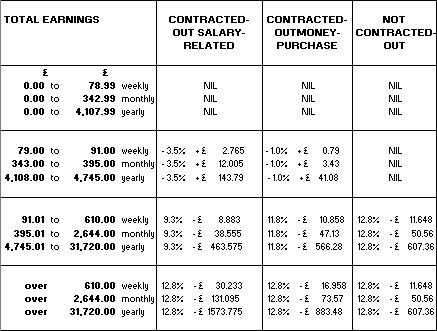|
How National Insurance (NI) is calculated
Employer's National Insurance contributions are set by the Government
and changes are notified through the Budget, usually taking effect
on 5th April. The table below shows how SiriusWeb calculates the
NI costs.

NI rates shown are as at 5th April 2004
The rate payable is determined by two factors:
1. Total earnings.
2. Pension scheme.
Total Earnings
This is the total earned in the year or part thereof and the table
shows the four separate earnings bands down the left-hand column.
Pension Scheme
The pension scheme can be one of three types (shown in the three
columns to the right of the Total Earnings column).
1. Contracted-out (salary -related)
This is where a member of staff has opted out of the state pension
scheme (SERPS) and is paying salary related contributions to a company
pension scheme (eg USS).
2. Contracted-out (money-purchase)
This is also where a member of staff has opted out of SERPS and
is paying a private non-salary-related contribution rate (this is
a fairly uncommon scheme in the HE sector but would be where the
member of staff had their own private pension scheme).
SiriusWeb will calculate the NI cost according to which option
is chosen ('salary related' and 'money purchase' are the two possible
types of private pension scheme) however it will leave the pension
cost as £0. This is because private pension schemes vary widely
as to the level of employer contributions and so there is no 'standard'
cost. Thus such costs have to be worked out manually, based on the
details of the specific scheme an employee or prospective employee
is in.
3. Not Contracted-out
This rate is used where the member of staff is paying pension contributions
to the state pension scheme (SERPS) and is the default pension scheme
unless the member of staff has contracted out.
NI - Calculation Example
Lecturer A, UAP Point 8 £22,954
fte 100%
Pension USS
Employment period 01/08/2004 to 5/9/2004
| |
|
| |
Notes |
 |
Worked Example |
| 1. |
Divide salary figure by
12 to determine monthly amount. |
 |
22954/12=1912.83 |
| |
|
| 2. |
From this you can see that the
earnings fall into the third band (being between 395.01
- 2644). |
 |
Third band |
| |
|
| 3. |
As the person is in
USS (a contracted-out salary-related scheme) we can see
that the NI calculation must be 9.3% -£38.555 of
the total earnings between 01/08/04 and 5/9/04. |
 |
9.3% -£38.555 |
| |
|
| 4. |
From the salary
calculation we have ascertained that the salary for the
period comes to £2,323 (including 4.1% inflation). |
 |
£2,323 |
| |
|
| 5. |
Calculate 9.3%
of earnings. |
 |
(2323x0.093)=216.039 |
| |
|
| 6. |
Minus 38.555
for August. |
 |
216.039-38.555= 177.48 |
| |
|
| 7. |
Then minus 6.42 (which is
a 30th of 38.555 for the five days of September). |
 |
177.48 - 6.42 = 171.06
(rounded to £171) |
Therefore £171 is the
employer's NI contribution for this estimate.
|



